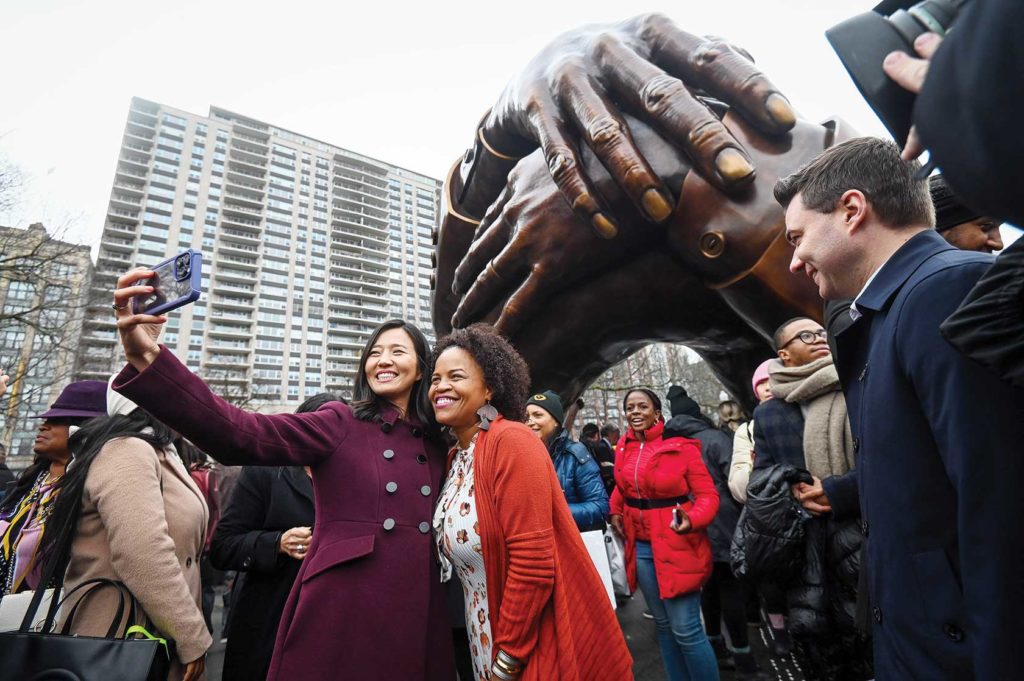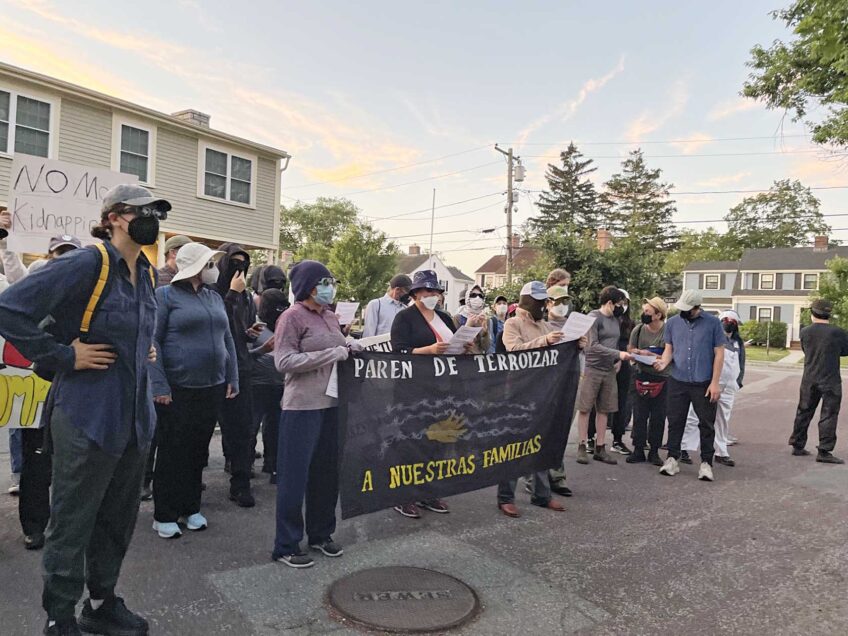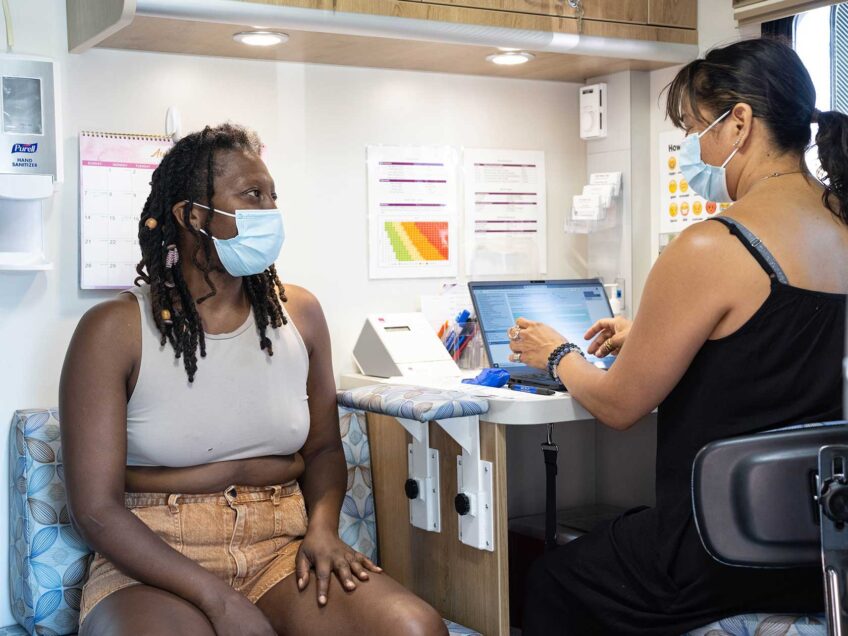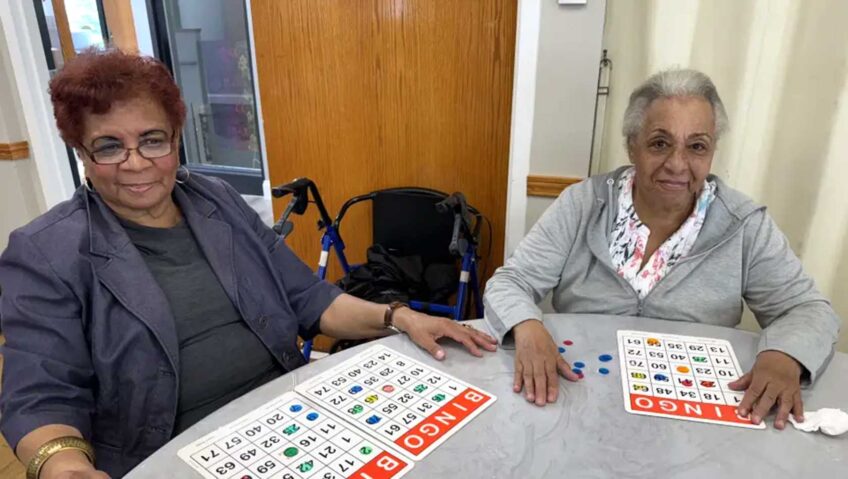Boston comes together for ‘Embrace’ unveiling
Hundreds turn out for monument honoring the Kings

A striking monument to the love of civil rights icons Coretta Scott King and the Rev. Martin Luther King Jr. — years in the making — was unveiled on the Boston Common last Friday during a landmark event celebrating the full history and culture of Black Boston.
The bronze sculpture of the couple’s arms encircled in a tender and timeless embrace, inspired by a 1964 photo from the Nobel Peace Prize ceremony, was slipped like a heart-shaped ring on the finger of a city with a history of both Black achievement and white resistance.
For one day at least, the bitter fruit of Boston’s legacy was set aside in favor of an unprecedented African American lovefest taking over America’s oldest public park, with over 1,000 attendees laughing, cheering and weeping as speakers extolled the principles of faith, hope and love before the drape was pulled and billowed to the ground, revealing the full design.
Spectators rushed in to surround the 22-foot-high memorial, stand close to its glowing bronze skin and look up to marvel at the clasping hands and arms — so huge but at the same time so accessible and intimate.
Hundreds more tramped through mud and rain-soaked grass to press at the chain-link fence surrounding the site, where, at its heart, stood “The Embrace,” a $10 million project meant to capture the spirit of love that animated the King couple’s philosophy of non-violent social resistance in service to the creation of the “Beloved Community.”
“Whenever I’ve come to Boston in the past, I’ve always felt a powerful bond of solidarity with this great American city,” said Martin Luther King III with his wife, Andrea Waters King, and daughter, the precocious Yolanda, standing at his side. Speaking on a stage set up just steps away from the Parkman Bandstand where his father in 1965 led a protest of Boston school segregation, he added, “Of course, it is the city where my parents met, fell in love and decided to create a family. In a way, I owe my very existence to Boston.”
Martin Luther King Jr. came to Boston in the early 1950s, after graduating from Morehouse College, to earn a Ph.D. in theology at Boston University. He met and married Coretta Scott, a student at the New England Conservatory of Music. They moved back South where King was soon embroiled in the 1955 Montgomery bus boycott and a cascading series of civil rights clashes that vaulted him to global prominence.
The new 40-foot-wide bronze sculpture on the Common, poised on three elbows and open to the sky, was abstractly conceived by Paul English, a Boston-based investor, during visits to San Francisco’s memorial to the slain civil rights leader.
English brought in venture capitalist Demond Martin, an Obama Foundation board member, as co-founder of Embrace Boston, and recruited two local pastors, former broadcaster Liz Walker of the Roxbury Presbyterian Church and the Rev. Jeffrey Brown of Twelfth Baptist, to co-chair efforts to realize the plan.
Starting in 2017, three Boston mayors — Marty Walsh, Kim Janey and Michelle Wu — helped advance the project as a national design competition received over 100 entries, resulting in the final selection of an unusual entry by artist Hank Willis Thomas.

Embrace Boston Executive Director Imari Paris Jeffries enjoys a moment with former
Mayor Kim Janey and Mayor Michelle
Wu PHOTO: JEREMIAH ROBINSON, MAYOR’S OFFICE
“This work is really about the capacity of each of us to be enveloped in love, and I feel enveloped in love every time I hear the names and see the faces of Dr. King and Coretta Scott King,” said Thomas.
Notables from the worlds of politics and business and culture heard heartfelt remarks from emcee Latoyia Edwards, the NBC Boston news anchor, who grew up in the Columbia Point housing project, as well as Imari Paris Jeffries, executive director of Embrace Boston, who choked back tears as he stood at the podium and thanked all who made the day possible.
Mayor Wu and newly inaugurated Gov. Maura Healey added eloquent tributes before U.S. Rep. Ayanna Pressley and former Gov. Deval Patrick closed the program with soaring rhetoric, turning the muddy Common into a sacred sanctuary.
“Dr. King’s vision was a radical one, considered bold for the times — full inclusion, equity, a redistribution of wealth and resources, and voting rights. In word and deed, he sought to affirm that Black Lives Matter,” said the congresswoman.
“And in the face of threats, indignity, violence, brutality and even isolation and marginalization because of his radical views, Dr. King still led with love,” she continued. “Love of God, love of humanity, love of justice. And in this great city of Boston, he found the love of his life: Miss Coretta Scott, who became a devoted wife, trusted confidant, advisor, effective strategist and activist in her own right. Theirs is the transformative power of love, of Black love.”
The statue sits in the center of 1965 Freedom Plaza, a circular space floored in granite slabs with the names of 69 Boston freedom fighters set in bronze strips around the monument. The honored individuals all took part in the struggle for civil, political and economic advancement during the King years, stretching from the 1950s to the present.
Former state Rep. Byron Rushing, a noted historian and a pioneering champion of gay rights during his decades in office on Beacon Hill, said he was surprised to see his name engraved in bronze. “I thought it was a piece of paper,” he said. “What I tried to do and anything I managed to accomplish is honor enough.”
The names take their place on the Common alongside those of Crispus Attucks, the Black martyr of the 1770 Boston Massacre, memorialized by a nearby obelisk facing Tremont Street, and the unnamed African American soldiers of the Civil War’s 54th Regiment in the bronze bas-relief facing the State House.
Among those attending the ceremony Friday was Bill Wright, a 1969 Boston Latin School graduate who marched with King from the Carter Playground in Lower Roxbury to the Common as part of the 1965 protest. “It was inspirational. It was hopeful,” he said. “The eyes of America were on Boston that day.”
Six-year-old Brooke Lynne Spencer traveled to the Common with her father to see the historic unveiling. “We’re here to celebrate,” she said, standing beneath the hand of Coretta Scott King. “I think it’s really cool because it has lots of details like jewelry,” said Spencer, pointing to the pearl bracelet around the bronze wrist.
One spectator, overheard talking about the design, said she was unconvinced until she got up close. “Then you get it,” she said, foreshadowing online debates — some of them salacious — about remembering the Kings without visual representation of their faces.
But for the audience at the Common, reviews of the statue were universally raving.
Gov. Patrick praised the endearing hug while noting the principled courage of Martin and Coretta to stand up for American ideals too often observed in the breach.
“They never mocked American ideals. They lived them,” he said. “They lived American ideals by being the light that drove out the darkness.”
Patrick ended by encouraging all to embrace. “Once we do, our embrace is warm and firm and lasting. And each time we embrace strangers or each other, we become stronger.”









